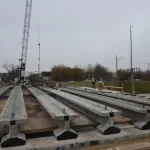All about Carbon Fiber Reinforced Concrete
The relentless pursuit of more durable, stronger, and efficient construction materials has led the civil engineering world to explore a wide variety of materials, one of which is carbon fiber reinforced concrete. This innovative material, also known as carbon fiber reinforced polymer (CFRP), is heralded as a game-changer in the construction industry, delivering superior strength, longevity, and design flexibility.
Topics
- Definition
- History
- Chemistry
- Manufacturing
Properties - Mechanisem
- Types
- Applicatons
- Advantages
- Disadvantages
- Challenges
- Standards
- 5 case studies
- How to use
- Related question and answers
- FAQs
- Refrences
1. Definition
Carbon fiber reinforced concrete is a type of composite material where traditional steel reinforcement bars or rebars are replaced with carbon fibers.
The carbon fibers, known for their high tensile strength and low weight, are typically embedded into a cementitious matrix. This combination of high-performance fibers within the concrete matrix results in a material that exhibits significant advantages over conventional reinforced concrete.
2. History
The concept of carbon fiber reinforced concrete originated in the 1960s, shortly after the inception of carbon fiber itself. As the unique properties of carbon fiber, such as high strength-to-weight ratio and resistance to corrosion, became apparent, researchers began to explore its potential in concrete reinforcement.
The first practical applications appeared in the 1970s and 1980s, primarily in Japan. Over the decades, the adoption of CFRP in civil engineering has steadily grown, culminating in the widespread recognition and use it enjoys today.
3. Chemistry
The chemistry of carbon fiber reinforced concrete revolves around the properties of its two main components – the carbon fibers and the cementitious matrix.
Carbon fibers are typically made from polyacrylonitrile (PAN) or pitch, which undergo a series of heat treatments to remove non-carbon atoms, resulting in strands composed almost entirely of carbon atoms. The bonds between these carbon atoms are incredibly strong, providing the fibers with their characteristic strength.
The cementitious matrix, on the other hand, binds these carbon fibers together. The matrix typically comprises water, aggregate, and Portland cement, a mixture of calcium, silicon, aluminum, iron, and small amounts of other ingredients heated in a kiln. This combination creates a hard, durable substance, acting as the perfect housing for the carbon fibers.
4. Manufacturing
The manufacturing process of carbon fiber reinforced concrete begins with the production of carbon fibers. These fibers are then coated with an epoxy resin to ensure better bonding with the concrete. The coated fibers are laid down in sheets or woven into fabric-like sheets, and these are then incorporated into the concrete matrix during the casting process.
It’s crucial that the carbon fibers are uniformly distributed throughout the concrete to maximize its strength and performance. As the concrete cures, the fibers become an integral part of the structure, providing additional tensile strength and ductility that would not be present in traditional concrete.
5. Properties
Carbon fiber reinforced concrete offers numerous impressive properties. Firstly, the material boasts an impressive strength-to-weight ratio, making it ideal for structures requiring high strength but with weight restrictions. Its high tensile strength makes it more resistant to cracking and other forms of structural damage.
Furthermore, CFRP exhibits exceptional resistance to environmental damage. Unlike steel, carbon fiber does not rust, making CFRP reinforced concrete less susceptible to corrosion-related damage, extending the service life of structures.
6. Mechanism
The mechanism through which carbon fiber reinforced concrete operates is relatively straightforward. When a load is applied to the concrete, it’s the carbon fibers that bear most of the tensile stress, not the concrete. The fibers act as a ‘crack arrester’, preventing cracks from spreading once they form in the concrete.
7. Types
There are two main types of carbon fiber reinforced concrete: 1) discontinuous (or short) fiber reinforced concrete and 2) continuous (or long) fiber reinforced concrete.
Discontinuous CFRP consists of short, randomly oriented carbon fibers dispersed throughout the concrete matrix.
It is commonly used in applications requiring modest enhancements to the tensile strength and toughness of the concrete.
Continuous CFRP, on the other hand, involves the use of longer, oriented fibers or woven carbon fiber fabric sheets. These fibers are typically laid in the direction of the anticipated tensile stresses. This type of CFRP provides a more significant increase in tensile strength and ductility and is used for demanding structural applications or where the direction of loading is well defined.
There are also hybrid varieties of carbon fiber reinforced concrete where carbon fibers are combined with other types of fibers such as glass or aramid. This approach can provide a balance between performance and cost and can be tailored to meet the specific requirements of a project.
8.Applications
a) Infrastructure Development
CRC has proven invaluable in the construction of bridges, tunnels, roads, and other key elements of infrastructure. Its enhanced tensile strength, corrosion resistance, and longevity make it a prime choice for structures requiring superior endurance. CRC helps to reduce maintenance costs and increase the lifespan of such critical structures.
b) High-Rise Buildings
The strength and lightness of CRC make it ideal for constructing high-rise buildings. Its ability to withstand high pressure and extreme weather conditions makes it a preferred material in the development of skyscrapers and other tall structures, contributing to safer and more sustainable urban landscapes.
c) Seismic Resistant Structures
CRC’s enhanced ductility makes it perfect for areas prone to earthquakes. Structures made with this material are more likely to withstand seismic activity, reducing the potential for catastrophic damage and loss of life in earthquake-prone regions.
d) Underwater Structures
Thanks to its excellent corrosion resistance, CRC is a go-to material for underwater constructions like piers, offshore platforms, and even undersea tunnels. Its long-lasting nature reduces the need for regular maintenance in these challenging environments.
e) Airport Runways and Hangers
CRC’s durability and resistance to wear and tear make it an excellent choice for constructing airport runways and hangers. Its high load-bearing capacity and resistance to weather extremes ensure that such structures can withstand the constant use and heavy machinery typical in these settings.
f) Green Building Practices
Carbon reinforced concrete aligns well with sustainable construction methods. Its long lifespan, coupled with a reduced need for repairs and replacement, results in lower carbon emissions over the life of a structure. Moreover, carbon fibres are recyclable, further enhancing the environmental credentials of this innovative material.
9.Advantages
a) Superior Strength
Carbon reinforced concrete is significantly stronger than traditional concrete. The addition of carbon fibres intensifies the tensile strength, which results in a material able to withstand increased loading and stress.
b) Durability
The exceptional durability of carbon reinforced concrete is a major selling point. It displays superior resistance to weathering, corrosion, and degradation, making it perfect for long-lasting structures.
c) Lightweight
Despite its enhanced strength, carbon reinforced concrete is lightweight. This reduced weight can lead to significant cost savings in transportation and handling, and allows for more creative and innovative architectural designs.
d) Improved Aesthetics
The thin profile and clean lines of carbon reinforced concrete can lead to aesthetically pleasing architectural designs. With its modern, sleek appearance, it offers architects a new tool for creating innovative and aesthetically appealing structures.
e) Resilience to Fire and Heat
Carbon fibres are highly resistant to fire and heat, making carbon reinforced concrete a safer choice for constructions in areas prone to high temperatures or fire hazards.
f) Eco-Friendly
Given the long lifespan and low maintenance requirements, carbon reinforced concrete could be considered a more eco-friendly construction material. Furthermore, carbon fibre production requires less energy compared to the production of steel, resulting in fewer carbon emissions.
10. Disadvantages
a) High Initial Cost
The first and foremost disadvantage of carbon-reinforced concrete is its high initial cost. Whilst its durability and strength can be touted as cost-saving in the long term, the upfront expenditure can be prohibitively high for many construction projects. Carbon fibre, the main component used for reinforcement, is significantly more expensive than conventional steel rebar.
b) Specialised Knowledge and Skill Requirements
The installation of carbon-reinforced concrete requires specialized knowledge and techniques. Traditional concrete workers may lack the necessary skills and training, thereby necessitating the involvement of expert professionals which again adds to the overall cost.
c) Limited Flexibility
Unlike steel, carbon fibre is not ductile. Therefore, carbon-reinforced concrete does not perform as well under tension as steel-reinforced concrete. This reduced flexibility can result in catastrophic failure during extreme load or stress situations.
d) Environmental Impact
Whilst carbon fibre itself is a non-depleting resource, the manufacturing process is energy-intensive and contributes to environmental degradation. In comparison, steel rebar production, whilst also impactful, is currently more energy-efficient and has a more established recycling process.
e) Disposal Issues
Carbon fibre recycling and disposal is a nascent field with limited commercial viability. This poses a significant problem at the end of the carbon-reinforced concrete structure’s lifecycle, potentially causing environmental harm.
f) Limited Research and Standardisation
While the benefits of carbon-reinforced concrete have been acknowledged, the technology is relatively new, and there is limited research on its long-term performance. The lack of standardisation also poses a challenge to its widespread adoption.
11. Challenges
a) High Initial Cost
The first and foremost disadvantage of carbon-reinforced concrete is its high initial cost. Whilst its durability and strength can be touted as cost-saving in the long term, the upfront expenditure can be prohibitively high for many construction projects. Carbon fibre, the main component used for reinforcement, is significantly more expensive than conventional steel rebar.
b) Specialised Knowledge and Skill Requirements
The installation of carbon-reinforced concrete requires specialized knowledge and techniques. Traditional concrete workers may lack the necessary skills and training, thereby necessitating the involvement of expert professionals which again adds to the overall cost.
c) Limited Flexibil
ty: Unlike steel, carbon fibre is not ductile. Therefore, carbon-reinforced concrete does not perform as well under tension as steel-reinforced concrete. This reduced flexibility can result in catastrophic failure during extreme load or stress situations.
d) Environmental Impact
Whilst carbon fibre itself is a non-depleting resource, the manufacturing process is energy-intensive and contributes to environmental degradation. In comparison, steel rebar production, whilst also impactful, is currently more energy-efficient and has a more established recycling process.
e) Disposal Issues
Carbon fibre recycling and disposal is a nascent field with limited commercial viability. This poses a significant problem at the end of the carbon-reinforced concrete structure’s lifecycle, potentially causing environmental harm.
f) Limited Research and Standardisation
While the benefits of carbon-reinforced concrete have been acknowledged, the technology is relatively new, and there is limited research on its long-term performance. The lack of standardisation also poses a challenge to its widespread adoption.
12. Standards
ACI ASTM BSI
13. Case Studies
a) The CUBE Project, Germany
This is a two-storey building constructed at the Technical University of Dresden. It’s the first building of its kind made almost entirely of carbon-reinforced concrete and serves as a prototype for this innovative construction method.
b) BASTA Project, Switzerland
The Swiss Federal Laboratories for Materials Science and Technology (Empa) constructed a footbridge in Dübendorf using carbon-reinforced concrete, showcasing the potential for the material in civil engineering.
c) The Shasta House, United States
An ambitious project by the University of Southern California, the Shasta house demonstrates the potential for carbon-reinforced concrete in residential construction.
d) Carbonhaus Project, Germany
Another notable initiative in Germany, the Carbonhaus project is a multi-storey residential building constructed with carbon-reinforced concrete, aimed at demonstrating the potential for carbon fibre reinforcement in residential housing.
e) The Bikeway, Netherlands
The world’s first bicycle path made from carbon-reinforced concrete was unveiled in the Netherlands, illustrating the material’s potential for smaller-scale and infrastructure applications.
14. How to Use
a) Understanding Carbon Fibre
Carbon fibre is a high-strength, high-stiffness material that’s ideal for reinforcing concrete. It’s essential to familiarise oneself with the properties and capabilities of carbon fibre before use.
b) Acquiring Quality Carbon Fibre
Ensure you source your carbon fibre from a reputable supplier. Quality carbon fibre is crucial for the structural integrity of the concrete.
c) Preparation of Concrete Mix
Traditional concrete is a blend of cement, water, and aggregate. However, when using carbon fibre, you may need to adjust your mix to accommodate the new material. Consulting an expert or following a well-established formula can be useful in this step.
d) Adding Carbon Fibre to the Mix
Carbon fibres are typically added to the concrete mix during the mixing process. It’s essential to distribute the fibres evenly to ensure optimal reinforcement.
e) Mixing the Concrete
Thorough mixing ensures that the carbon fibres are evenly distributed throughout the concrete. It’s crucial to maintain the correct ratio of ingredients to prevent a too-dense or too-loose mixture.
f) Pouring the Concrete
Pour the carbon-reinforced concrete mix into the prepared formwork or mould. It’s vital to evenly distribute the mixture and reduce the occurrence of air pockets.
g) Curing the Concrete
After pouring, the concrete should be allowed to cure for a specified time. During this period, the concrete hardens and gains strength, with the carbon fibres providing added reinforcement.
h) Inspecting and Testing
Once cured, the carbon-reinforced concrete should be inspected and tested for strength and durability. Any discrepancies should be addressed immediately.
Remember, using carbon fibre in concrete requires a thorough understanding of the material and the mixing process. Don’t hesitate to consult with a professional if you’re uncertain about any step in this process.
15. FAQs
a) What is Carbon Fiber Reinforced Concrete (CFRC)?
Carbon Fiber Reinforced Concrete (CFRC) is a type of concrete that incorporates carbon fibers into the mix to enhance its strength and durability. It’s a popular choice for construction projects that require higher resilience and longevity.
b) What are the advantages of using Carbon Fiber Reinforced Concrete?
CFRC has many advantages. Its primary benefit is that it’s significantly stronger than traditional concrete. It’s also more resistant to weathering, cracking, and wear and tear. This makes it an ideal material for structures that need to withstand heavy loads or harsh conditions.
c) How does Carbon Fiber Reinforced Concrete compare to traditional concrete?
CFRC is superior to traditional concrete in several ways. It is more durable, has a higher tensile strength, and is more resistant to environmental factors such as changes in temperature and humidity. However, it can be more expensive and requires specialist knowledge to mix and apply correctly.
d) In which applications is Carbon Fiber Reinforced Concrete most commonly used?
CFRC is commonly used in heavy-duty construction projects such as bridges, high-rise buildings, and tunnels. Its high strength and durability also make it suitable for use in seismic retrofitting to increase the resilience of structures to earthquakes.
e) Is Carbon Fiber Reinforced Concrete more expensive than traditional concrete?
Yes, CFRC is generally more expensive than traditional concrete due to the cost of the carbon fibers. However, considering its strength and durability, it can provide long-term cost savings through reduced maintenance and repair costs.
f) What is the carbon fiber content in Carbon Fiber Reinforced Concrete?
The carbon fiber content in CFRC can vary depending on the specific requirements of the project. However, it’s typically between 0.5% and 2% by volume. The carbon fibers work to improve the tensile strength of the concrete, making it less susceptible to cracking.
g) How is Carbon Fiber Reinforced Concrete manufactured?
CFRC is manufactured similarly to traditional concrete, but with the addition of carbon fibers into the mix. These fibers are added to the concrete mix during the mixing stage, ensuring they are evenly distributed throughout the concrete for optimal strength and durability.
h) Can Carbon Fiber Reinforced Concrete be recycled?
Like regular concrete, CFRC can be recycled, but the process is more complex due to the embedded carbon fibers. The recycling process involves breaking down the concrete into smaller pieces, which can then be reused as aggregate in new concrete mixes.
i) Does Carbon Fiber Reinforced Concrete require special maintenance?
CFRC generally requires less maintenance than traditional concrete due to its increased durability and resistance to wear. However, regular inspections are still recommended to ensure the material’s integrity over time.
j) What is the future of Carbon Fiber Reinforced Concrete in the construction industry?
With its superior properties and potential cost savings over the long term, CFRC is expected to see increasing use in the construction industry. As more builders recognise its benefits and the technology continues to advance, it’s likely that the use of CFRC will become more widespread.
16. Refrences
ASCE ICE GSC MPDI Nature





Recent Comments